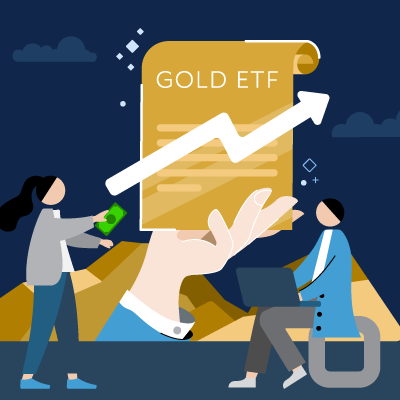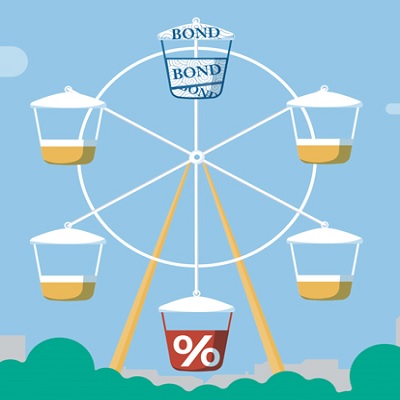You can invest in gold via:
- Purchasing physical gold
- Gold-linked currency investments
- Gold ETFs or unit trusts
- Gold mining stocks
The most common way to invest in physical gold is to purchase gold bullion. Gold bullion refers to investment-grade gold, commonly in the form of bars, ingots, or coins.
Investment-grade gold is always at least 99.5 per cent pure:
- Gold bars will have the manufacturer’s name, weight, and purity stamped on it. Gold bars typically range from 1/10 troy ounce (one troy ounce = 31.1 grams) to one kilogram.
- Gold coins come in a wider range of shapes and sizes. However, do note that you may be paying extra for design elements, such as engravings or collector value. Some coins are also accepted as legal tender in their country of origin, such as UK gold sovereigns, but they are rarely convenient to use as actual currency.
Physical gold can be purchased from some banks or brokers. Always ensure you purchase gold from reputable sellers only. It is generally best to purchase gold bullion from trusted local sources, rather than online. It’s also advantageous to purchase gold in Singapore, as it is an Investment Precious Metal (IPM), and thus exempt from Goods & Services Tax (GST).
- Investing in gold jewellery is an alternative way to get exposure to gold, but it is not the same as actual gold investment
This is because jewellery includes costs that are extrinsic to its gold content. For example, jewellery often involves paying for craftsmanship and branding, which are not related to the value of the gold.
Jewellery may also have intangible value outside of its gold content, such as its value as an antique. Most importantly, gold jewellery is not categorised as an IPM, and the usual GST rate of seven per cent applies when purchasing.
- Investing in physical gold should be accompanied by proper storage and insurance
There are some additional costs to owning physical gold. The most common of these is safe storage – many investors keep their gold bullion with the bank safety deposit boxes or vaults, rather than at home. Physical gold is susceptible to theft, especially in smaller and more portable forms such as gold coins.
Verification is also important when purchasing physical gold. It is crucial to ensure you pick a trustworthy seller; unethical gold-sellers may mix other metals into gold coins or bullions, thus reducing the gold content, or pass off tungsten as gold. In general, it’s best to look for dealers registered with the Monetary Authority of Singapore.
In addition, you should consult an insurance professional on the best way to insure your gold assets. Insurers may have requirements on how you store your gold, before they will agree to sell you a policy.
As with any commodity or investment, gold prices rise and fall based on market forces. Investors should bear in mind that the value of their gold will not be constant.
Coined Wall Street’s safe haven asset, gold is able to store its value in real terms amidst volatile Another way to invest in gold is to use gold currency investments. An example of this is to buy gold as a Commodity-Linked Structured Investment. Using this method, you decide with the bank or broker on the duration of the investment and a base currency – such as USD, SGD, and so on. You will need to agree on a Target Conversion Rate (TCR) to be applied between gold and the base currency. Gold is treated like a currency with a currency code of XAU.
At the end of the investment duration, you will get both principal and coupon in either gold (XAU) or the base currency. If gold (XAU) appreciates against the base currency -for instance, USD –you will be repaid in USD for both the principal and coupon. However, if gold (XAU) falls below the TCR, the investment will get converted and you will be repaid the equivalent of principal and coupon in gold (XAU) converted at TCR.
This method can generate more interest than just holding on to US dollars, for instance, and is ideal for investors who don’t mind being paid in gold (XAU). What are your options if you are repaid in gold? You can then hold on to, sell, or re-invest the gold (XAU) in another commodity-linked currency investment with gold as your base currency or commodity to potentially earn another round of higher coupon.
XAU given its currency-like tradability has been the subject to lots of financial innovation including derivatives with XAU as underlying for the more sophisticated investors. However, XAU, like many forms of forex-based investing, involves dealing with volatility. Prices and forex rates fluctuate constantly, and investors should be prepared to spend time tracking these movements. Importantly, there are other accompanying risks that investors should take note, such as market risk, principal risk and liquidity risk. Market risk refers to considerable fluctuations in value and other inherent risks associated with financial markets, while principal risk refers to investment being not principal protected so you may lose some or all of your initial investment amount, and liquidity risk means you may experience a principal loss if you make any withdrawals before its maturity.
A gold Exchange Traded Fund (ETF) allows you to invest in gold, without having to buy the physical gold assets. It is a fund that holds a range of different gold-backed assets. Some gold ETFs simply track or mimic the price movements of physical gold, whereas others may include shares in gold miners, or various gold-backed derivatives. The underlying asset is what dictates the value of the ETF and will therefore be the determining factor for its performance.
Gold ETFs can be traded like stocks, making them liquid and easy to sell off as and when required. They are also oftentimes cheaper to own for new investors, as you do not have to purchase actual gold, albeit you should check with a qualified broker for the spot price. This allows you to include gold in your portfolio, with a smaller commitment of capital.
A gold unit trust (UT) is also a fund, which consists of gold-related assets and derivatives. Similar to gold ETFs, some gold UT invest directly in physical gold, while some gold-related UTs invest in stocks of gold miners, other precious metals and bulk commodities. The main difference is that the unit trust is more actively managed; there are managers who handle the buying and selling of gold-related assets or derivatives in the fund. Ideally, the full-time professionals running the fund will be able to get better returns than an ETF, which simply mirrors gold price movements.
In both cases, there will be expenses incurred to manage the fund, although the management fees for ETFs tend to be slightly lower. You should also review the companies behind the funds, to ensure they are well capitalised and have an established history. As this can be difficult for investor to check, you may wish to consult a qualified financial advisor for advice. Do check the expense ratio for the funds or ETFs that you buy, and consult a qualified financial advisor if you’re not sure how to read the prospectus.
Gold ETFs and unit trusts can be conveniently purchased through a bank or licensed broker.
You can invest in companies mining for gold, rather than investing in gold itself. In theory, the shares of gold mining companies should go up as gold prices rise, as this increases the value of the company’s gold inventory.
There’s also a chance that – with skilled management – miners are able to spend less to extract a greater amount of gold, although conversely, poor management can result in less gold being extracted at greater cost. As such, this is both a potential upside as well as a downside. A mining company’s management is also an added risk factor, and investors need to be wary of mismanagement. Related risk factors include the company’s gearing or debt, as well as environmental or legal policies that could impact its existing operations.
In an environment where gold prices are falling, a gold mining company can impose cutbacks on spending to maintain profitability; something that a gold ETF or physical gold cannot do. Gold mining stocks may also deliver dividends, whereas physical gold and most gold ETFs do not. In particular, it’s important to understand that returns from mining stocks are dependent on the future returns of the company, not on gold prices. There are elements that are extrinsic to the price of gold, such as if the company also engages in other mining activities.
In August this year, Warren Buffet – who historically has not been a gold investor – through his investment company Berkshire Hathaway, invested almost half a billion US dollars into gold mining firm Barrick. This demonstrates how investors who may not be fully interested in gold can still seek to benefit from it, via the related mining industry.
Before buying a gold product, it’s best to seek the advice of a qualified financial advisor. Reach out to us at Standard Chartered. The correct amount of gold to invest in will vary based on your financial situation – factors like your investment horizon, risk profile, and current market conditions all play a role.
Aim to have a balanced, well-diversified portfolio, in which gold investments play a clear and specific role.





